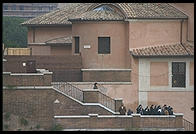
Color Printers
by Philip Greenspun; created August, 2001
Site Home : Photography : Color Printers
Inexpensive ink jet printers ($300 to $1000) can produce remarkably good quality photographs if you choose your paper carefully. These prints can also be archival if you choose your ink carefully. Epson and Canon typically make the best ink-jet printers for photographers. The Canon S800, for example is a good low-cost machine (about $300). The Epson Stylus Photo 2000P, about $750, offers Pigmented Archival Ink, good for making prints that can last 100 years, i.e., five times as long as a Genuine Kodak Paper print and almost twice as long as a standard print on Fuji paper. For the best user interface, look at the Kodak Personal Picture Maker 200 (about $150). This printer includes an LCD screen and slots for CompactFlash and SmartMedia cards. You can pop a storage card out of your camera and into the printer, scroll through your photos, and make prints of selected images all without using a personal computer.
Whatever printer you get, make sure to follow the manufacturer's recommendations for paper. You'll need expensive glossy paper to get photo-quality results.
Expect to suffer from color calibration problems with any ink jet. Your monitor is an RGB device. Your ink jet printer is a CMYK device. Good luck at getting anything out of the printer that resembles what you see on the monitor.
"Dye-sub" printers were among the first photo-quality color computer printers, emerging in the early 1990s. Sadly most of the prints made with these machines had faded by the time we entered the New Millennium. The latest dye-sub printers allegedly produce more archival prints but this whole technology seems to be fading in favor of ink jet.
Color management is a problem with dye-sub, as with ink jet. These are CMYK devices.
Though rather long in the tooth, this is the choice of most imaging professionals. The Fujix machines uses three lasers to expose a specially treated "donor paper" which is then thermally developed and transfered onto "receiver paper". It is a traditional silver halide process but one need not maintain chemistry or clean processor rollers. Resolution is 400 dpi on an 8.5x11 sheet (Fujix 3500) or 12x18 (Fujix 4000). Image quality is the best of any printer available, comparable to an Ilfochrome, and archival qualities are reputed to be good. The printer is a standard piece of office equipment and the expended donor paper goes back UPS to Fuji for recycling and disposal. Consumables cost $2-4 per page and you can make transparencies as well as opaque photos.
Another significant advantage of the Fujix over most color printers is that it is a true RGB device and thus one need not deal with the horrors of CMYK conversion. Even without going to special lengths with color management, you'll probably get a nice print on your first try.
The Fujix can be obtained from a handful of national retailers, including Adorama. The 4000 is about $13,000 and the 3500 is about $5500.
If you want to try Fujix printing before you buy, visit your local professional digital color lab. They'll probably have a machine.
A variety of companies make high-volume, high-cost machines that use RGB lasers to print onto standard photographic paper, either Ilfochrome or RA-4 negative printing paper. At their best, these can be as good as the Fujix printers and the per-page cost for media is much lower. Print size can be outrageously large. These machines usually print on rolls and can therefore make a print 50 meters long (but only 127 cm or 50" wide).
Vendors include Gretag Lab Systems, Durst Lambda, and CSI Lightjet. Whatever you choose, remember that these machines only expose paper. Development requires a standard RA-4 or Ilfochrome processor with traditional photo chemistry. Traditional photo chemistry implies that someone is cleaning and maintaining the processor regularly. Also note that expended photo chemistry constitutes a disposal problem: you can't just dump it down the sink.
For most people it is not practical to own one of these machines. You prepare your digital files and send them to a lab. If you aren't happy with your local labs, try ColorWorks in Portland, Maine or Precision Color (Michigan and Nevada; (702) 736-8400 ask for Pat).
For a painterly look, try an Iris ink-jet print onto watercolor paper. The machines themselves cost a lot and the original inks were not archival but it is an unusual way to make art that cannot be easily duplicated with other kinds of machines. Send a file to ColorWorks to try out Iris (Giclee) printing at its best.